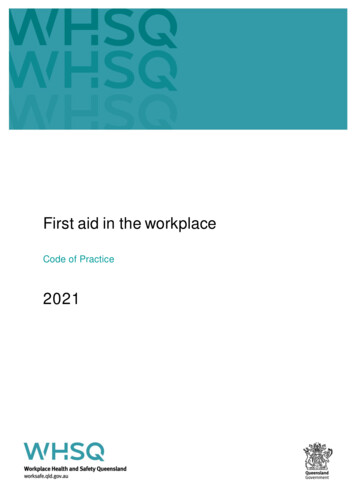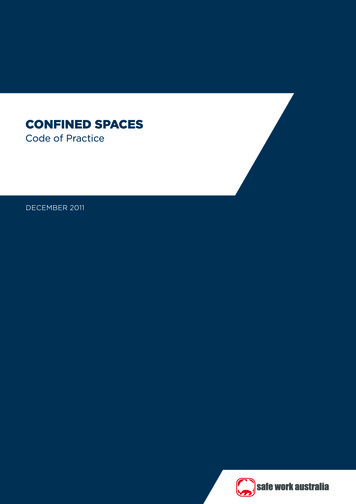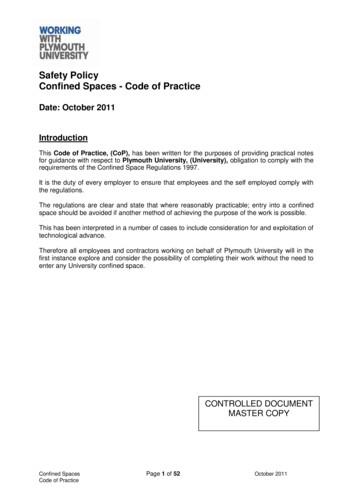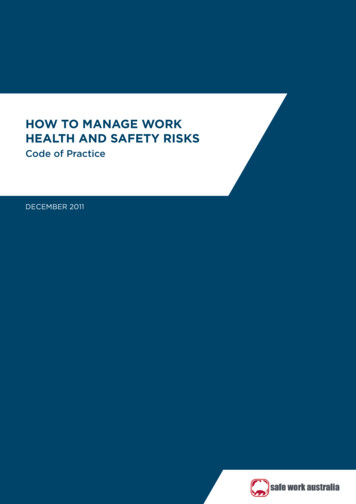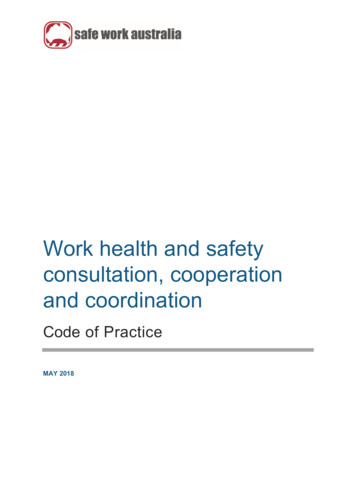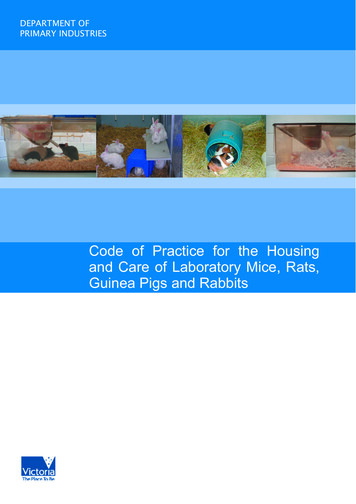
Transcription
CODE OF PRACTICEOnSafety ManagementOccupational Safety and Health BranchLabour DepartmentCODE OF PRACTICE ON SAFETY MANAGEMENT1
This Code of Practice is prepared by theOccupational Safety and Health BranchLabour DepartmentFirst edition April 2002This Code of Practice is issued free of charge and can be obtained from offices of theOccupational Safety and Health Branch. Its contents can also be downloaded from theLabour Department website at http://www.info.gov.hk/labour/public/index.htm through theInternet. For enquiries about addresses and telephone numbers of the offices, please contactus through telephone 2559 2297.This Code of Practice may be freely reproduced except for advertising, endorsement orcommercial purposes. Please acknowledge the source as "Code of Practice on SafetyManagement", published by the Labour Department.2CODE OF PRACTICE ON SAFETY MANAGEMENT
ONSIBILITIES OF PROPRIETORS AND CONTRACTORS114.DEVELOPING, IMPLEMENTING AND MAINTAINING A SAFETYMANAGEMENT SYSTEM185.4.1 How to develop a safety management system ?184.2 How to implement a safety management system ?234.3 How to maintain a safety management system ?254.4 Management model to develop, implement and maintain a safetymanagement system274.5 Application of the management model to individual elements of asafety management system284.6 Application of the management model to safety audits or safetyreviews29THE ELEMENTS OF A SAFETY MANAGEMENT SYSTEM305.1 A safety policy which states the commitment of the proprietoror contractor to safety and health at work315.2 A structure to assure implementation of the commitment to safetyand health at work345.3 Training to equip personnel with knowledge to work safely andwithout risk to health405.4 In-house safety rules to provide instruction for achieving safetymanagement objectives455.5 A programme of inspection to identify hazardous conditions andfor the rectification of any such conditions at regular intervals oras appropriate47CODE OF PRACTICE ON SAFETY MANAGEMENT3
6.5.6 A programme to identify hazardous exposure or the risk of suchexposure to the workers and to provide suitable personalprotective equipment as a last resort where engineeringcontrol methods are not feasible505.7 Investigation of accidents or incidents to find out the cause of anyaccident or incident and to develop prompt arrangementsto prevent recurrence545.8 Emergency preparedness to develop, communicate and executeplans prescribing the effective management of emergency situations585.9 Evaluation, selection and control of sub-contractors to ensure thatsub-contractors are fully aware of their safety obligations andare in fact meeting them605.10 Safety committees655.11 Evaluation of job related hazards or potential hazardsand development of safety procedures705.12 Promotion, development and maintenance of safetyand health awareness in a workplace775.13 A programme for accident control and elimination of hazardsbefore exposing workers to any adverse work environment795.14 A programme to protect workers from occupational health hazards83SAFETY AUDIT886.1 What is a "Safety Audit" ?886.2 The appointment of a registered safety auditor to conduct a safetyaudit926.3 Assistance, facilities and information to be provided for the purposes 96of safety audit6.4 Things to observe when the safety auditor is an employee of theproprietor or contractor4996.5 Actions to be taken on safety audit report1006.6 Obligation to produce safety audit report or plan for inspection103CODE OF PRACTICE ON SAFETY MANAGEMENT
7.SAFETY REVIEW1047.1 What is a "Safety Review"?1047.2 The appointment of a safety review officer to conduct a safety review1087.3 Assistance, facilities and information to be provided for thepurposes of safety review1117.4 Things to observe when the safety review officer is an employee ofthe proprietor or contractor1147.5 Action to be taken on safety review report1157.6 Obligation to produce safety review report or plan for inspection118REFERENCES119USEFUL INFORMATION122CODE OF PRACTICE ON SAFETY MANAGEMENT5
1. INTRODUCTIONIn 1995, the Government conducted a comprehensive review of industrial safetywith a view to mapping out Hong Kong's long-term safety strategies. The Reviewconcluded that for Hong Kong to achieve high standards of safety and health atwork, enterprises must embrace self-regulation and safety management. TheReview recommended that the Government should provide a framework withinwhich self-regulation was to be achieved through a company system of safetymanagement.Against this background, the Government has introduced a safety managementsystem consisting of 14 elements. It has promoted the system through launchingpilot schemes, publishing an Occupational Safety Charter, organising seminarsand promotional visits, and issuing a Guide to Safety Management.This system is now enshrined in the Factories and Industrial Undertakings (SafetyManagement) Regulation [hereinafter called "the Safety ManagementRegulation"] passed on 24 November 1999.Under the Safety Management Regulation, proprietors or contractors of certainindustrial undertakings are required to develop, implement and maintain inrespect of the undertakings a safety management system which contains anumber of key process elements. They are also required to have the systemregularly audited or reviewed.This Code of Practice on Safety Management [hereinafter called the COP] is aCode of Practice issued by the Commissioner for Labour under section 7A(1) ofthe Factories and Industrial Undertakings Ordinance (Cap. 59). It aims to providepractical guidance for proprietors and contractors of relevant industrialundertakings to comply with the aforesaid legal requirements. It sets out, inPart 4, how proprietors or contractors should develop, implement and maintaina safety management system. It provides, in Part 5, practical guidance in respectof the 14 elements of a safety management system. It also provides, in Part 6and Part 7, practical guidance on safety audits and safety reviews.First and foremost, however, proprietors and contractors should refer to Part 3of this COP for practical guidance on their level and scope of responsibilitiesunder the Safety Management Regulation in relation to their industrialundertakings' size of employment and the value of work undertaken.6CODE OF PRACTICE ON SAFETY MANAGEMENT
IntroductionThis COP has a special legal status. Although failure to observe any guidance given inthis COP is not in itself an offence, that failure may be taken by a court in criminalproceedings as a relevant factor in determining whether or not a person has breachedany of the provisions of the Safety Management Regulation to which the guidancerelates.The statutory provisions referred to or quoted in this COP are those in force on1 April 2002.CODE OF PRACTICE ON SAFETY MANAGEMENT7
2. INTERPRETATIONIn this COP, unless the context otherwise requires "construction site" ( !) means a place where construction work isundertaken and also any area in the immediate vicinity of any such place whichis used for the storage of materials or plant used or intended to be used for thepurpose of the construction work;"copy" ( ), in relation to any document, includes the original of the document;"designated undertaking" ( !) means an industrial undertaking involving anyof the following activities (a)the generation, transformation and transmission of electricity;(b)the generation and transmission of town gas, or liquefied petroleum gas,within the meaning of section 2 of the Gas Safety Ordinance (Cap. 51); or(c)container handling;"hazard"* ( ) means a source or a situation with a potential for harm in terms ofhuman injury or ill-health, damage to property, damage to the environment, or acombination of these;"ill-health"* ( !) means ill-health that is judged to have been caused by ormade worse by a person's work activity or work environment;"incident"* ( ) means an unplanned event which has the potential to lead toaccident;"registered" ( ) means registered under section 6(1) of the Safety ManagementRegulation as a safety auditor or scheme operator;"registered safety auditor" ( !"# ) means a person registered as a safetyauditor;"registered scheme operator" ( scheme operator;!"# ) means a person registered as a"relevant industrial undertaking" ( !"#), in relation to a proprietor orcontractor specified in Schedule 3 of the Safety Management Regulation, means theindustrial undertaking specified in that Schedule (and howsoever worded) inconnection with the proprietor or contractor, as the case may be;"risk"* ( !") means the combination of the likelihood and consequenceof a specified hazardous event occurring;8CODE OF PRACTICE ON SAFETY MANAGEMENT
Interpretation"risk assessment"* ( !) means the overall process of estimating themagnitude of risk and deciding whether or not the risk is tolerable. It alsoincludes the process of recognizing that a hazard exists and defining itscharacteristics;"risk control"* ( !) means the overall process of developing,implementing and maintaining the safety procedures and risk controlmeasures. It also includes the review of the safety procedures and risk controlmeasures;"safety audit" ( !) means an arrangement for -(a)c o l l e c t i n g , a s s e s s i n g a n d v e r i f y i n g information on the efficiency,effectiveness and reliability of a safety management system (including theelements specified in Schedule 4 of the Safety Management Regulationcontained in the system); and(b)considering improvements to the system;"safety audit report" ( !"#) means a report compiled by a registeredsafety auditor after the completion of a safety audit;"safety auditor" ( !") means a person who conducts or proposes toconduct safety audits;"safety committee" ( !") m e a n s a s a f e t y c o m m i t t e e e s t a b l i s h e dunder section 10 of the Safety Management Regulation;"safety management" ( !) means the management functions connected withthe carrying on of an industrial undertaking that relate to the safety of personnelin the undertaking, including (a)the planning, developing, organizing and implementing of a safety policy;and(b)the measuring, auditing or reviewing of the performance of those functions;"safety management system" ( !"#) means a system which providessafety management in an industrial undertaking;CODE OF PRACTICE ON SAFETY MANAGEMENT9
Interpretation"safety plan" *( !) means a plan for carrying out a safety policy;"safety review" ( !) means an arrangement for -(a)reviewing the effectiveness of a safety management system (includingt h e elements specified in Schedule 4 of the Safety ManagementRegulation contained in the system); and(b)considering improvements to the effectiveness of the system;"safety review officer" ( !") means a person who is appointed to conduct asafety review under section 19(1) (a) of the Safety Management Regulation;"safety review report" ( !"#) means a report compiled by a safety reviewofficer after the completion of a safety review;"scheme" ( ) means a scheme to train persons to be safety auditors;"scheme operator" ( operate a scheme;!") means a person who operates or proposes to"shipyard" ( ) means any yard or dry dock (including the precincts thereof) inwhich ships or vessels, except ships or vessels afloat, are constructed,reconstructed, maintained, repaired, refitted, finished or broken up.Note :The above ter ms, except those marked with "*", are given themeanings as stipulated under section 2 of the Safety ManagementRegulation.10 CODE OF PRACTICE ON SAFETY MANAGEMENT
3. RESPONSIBILITIES OF PROPRIETORSAND CONTRACTORSUnder the Safety Management Regulation, a proprietor or contractor specified inSchedule 3 is required to develop, implement and maintain in respect of the relevantindustrial undertaking a safety management system, consisting of some or all of the elementsstipulated in Schedule 4.Schedule 3 is divided into 4 parts (with each part containing one group of proprietors orcontractors) as follows :PART 11.A contractor in relation to construction work having an aggregate of 100 ormore workers in a day working in a single construction site.2.A contractor in relation to construction work with a contract value of 100million or more.3.A proprietor of a shipyard business having an aggregate of 100 or moreworkers in a day working in a single shipyard.4.A proprietor of a factory having an aggregate of 100 or more workersin a day working in a single factory.5.A proprietor of a designated undertaking having an aggregate of 100or more workers in a day working in a single workplace.PART 21.A contractor in relation to construction work having an aggregate of 50 ormore but less than 100 workers in a day working in a single constructionsite.2.A proprietor of a shipyard business having an aggregate of 50 or more butless than 100 workers in a day working in a single shipyard.3.A proprietor of a factory having an aggregate of 50 or more but lessthan 100 workers in a day working in a single factory.4.A proprietor of a designated undertaking having an aggregate of 50or more but less than 100 workers in a day working in a singleworkplace.CODE OF PRACTICE ON SAFETY MANAGEMENT 11
Responsibilities of Proprietors and ContractorsPART 31.2.3.4.5.6.A contractor in relation to construction work having an aggregate of 100 ormore workers in a day working in 2 or more construction sites.A proprietor of a shipyard business having an aggregate of 100 or moreworkers in a day working in 2 or more shipyards.A proprietor of a factory having an aggregate of 100 or more workers in aday working in 2 or more factories.A proprietor of a designated undertaking involving any one or more of theactivities specified in paragraph (a) of the definition of “designatedundertaking” in section 2(1) of this Regulation, having an aggregate of 100 ormore workers in a day working in 2 or more workplaces.A proprietor of a designated undertaking involving any one or more of theactivities specified in paragraph (b) of the definition of “designated undertaking”in section 2(1) of this Regulation, having an aggregate of 100 or more workersin a day working in 2 or more workplaces.A proprietor of a designated undertaking involving any one or more of theactivities specified in paragraph (c) of the definition of “designatedundertaking” in section 2(1) of this Regulation, having an aggregate of 100 ormore workers in a day working in 2 or more workplaces.PART 41.2.3.4.5.6.A contractor in relation to construction work having an aggregate of 50 ormore but less than 100 workers in a day working in 2 or more constructionsites.A proprietor of a shipyard business having an aggregate of 50 or more butless than 100 workers in a day working in 2 or more shipyards.A proprietor of a factory having an aggregate of 50 or more but less than100 workers in a day working in 2 or more factories.A proprietor of a designated undertaking involving any one or more of theactivities specified in paragraph (a) of the definition of “designated undertaking”in section 2(1) of this Regulation, having an aggregate of 50 or more but lessthan 100 workers in a day working in 2 or more workplaces.A proprietor of a designated undertaking involving any one or more of theactivities specified in paragraph (b) of the definition of “designated undertaking”in section 2(1) of this Regulation, having an aggregate of 50 or more but lessthan 100 workers in a day working in 2 or more workplaces.A proprietor of a designated undertaking involving any one or more of theactivities specified in paragraph (c) of the definition of “designated undertaking”in section 2(1) of this Regulation, having an aggregate of 50 or more but lessthan 100 workers in a day working in 2 or more workplaces.12 CODE OF PRACTICE ON SAFETY MANAGEMENT
Responsibilities of Proprietors and ContractorsA proprietor or contractor specified in Part 1 or Part 3 of Schedule 3 is required by theSafety Management Regulation to develop, implement and maintain in respect of therelevant industrial undertaking a safety management system which contains the10 elements as stipulated in Parts 1 and 2 of Schedule 4. [Sections 8(1) and 8(3) ofthe Safety Management Regulation]A proprietor or contractor specified in Part 2 or Part 4 of Schedule 3 is required by theSafety Management Regulation to develop, implement and maintain in respect of therelevant industrial undertaking a safety management system which contains the8 elements listed in Part 1 of Schedule 4. [Sections 8(2) and 8(4) of the SafetyManagement Regulation]Note:The implementation of the Safety Management Regulation will be reviewed one yearafter the Regulation has come into force to decide on the appropriate time to bring theremaining 4 elements listed in Part 3 of Schedule 4 into operation.CODE OF PRACTICE ON SAFETY MANAGEMENT 13
Responsibilities of Proprietors and ContractorsTHE SITUATION CAN BE GRAPHICALLY ILLUSTRATED BY THE FOLLOWING DIAGRAM:Part 1proprietor or contractorPart 2proprietor or contractorPart 3proprietor or contractorPart 4proprietor or contractorLEGENDSThe proprietor or contractor shall include the elements containedin this box in his safety management system14 CODE OF PRACTICE ON SAFETY MANAGEMENT
Responsibilities of Proprietors and ContractorsSafety policy1. A safety policy which states the commitment of the proprietor or contractor tosafety and health at work.Organisational structure2. A structure to assure implementation of the commitment to safety and health at work.Safety training3. Training to equip personnel with knowledge to work safely and without risk to health.In-house safety rules4. In-house safety rules to provide instruction for achieving safety managementobjectives.Inspection programme5. A programme of inspection to identify hazardous conditions and for therectification of any such conditions at regular intervals or as appropriate.Hazard control programme6. A programme to identify hazardous exposure or the risk of such exposure to theworkers and to provide suitable personal protective equipment as a last resortwhere engineering control methods are not feasible.Accident/incident investigation7. Investigation of accidents or incidents to find out the cause of any accident orincident and to develop prompt arrangements to prevent recurrence.Emergency preparedness8.Emergency preparedness to develop, communicate and execute plansprescribing the effective management of emergency situations.Evaluation, selection and control of sub-contractors1.Evaluation, selection and control of sub-contractors to ensure that subcontractors are fully aware of their safety obligations and are in fact meetingthem.Safety committees2.Safety committees to identify, recommend and keep under review measures toimprove the safety and health at work.Job-hazard analysis1.Evaluation of job related hazards or potential hazards and development of safetyprocedures.Safety and health awareness2.Promotion, development and maintenance of safety and health awareness in aworkplace.Accident control and hazard elimination3.A programme for accident control and elimination of hazards before exposingworkers to any adverse work environment.Occupational health assurance programme4.A programme to protect workers from occupational health hazards.N.B. see note at Page 13CODE OF PRACTICE ON SAFETY MANAGEMENT 15
Responsibilities of Proprietors and ContractorsOther related responsibilitiesIn addition to the duties to develop, implement and maintain a safety managementsystem under the Safety Management Regulation, a proprietor or contractor specifiedin Part 1 or Part 3 of Schedule 3 is also required to discharge his duties under (a)(b)(c)section 9 in relation to a safety policy1;sections 10 to 12 in relation to safety committees2; andsections 13, 14, 16(1) and 17 in relation to safety audits3.In addition to the duties to develop, implement and maintain a safety managementsystem under the Safety Management Regulation, a proprietor or contractor specifiedin Part 2 or Part 4 of Schedule 3 is also required to discharge his duties under (a)(b)section 9 in relation to a safety policy1; andsections 19, 20, 22(1), 23 and 24(2) in relation to safety reviews4.Responsibilities of the proprietors, contractors and sub-contractors in abig projectThe approach adopted in the Safety Management Regulation is capable ofcreating different layers of safety management systems to be implemented in abig enterprise or project. Therefore, a proprietor or contractor of, for example,a construction firm which operates construction sites at different locations isrequired to develop, implement and maintain a safety management system bothat the enterprise level and at the workplace level within its undertakings orconstruction sites, as long as the proprietor or contractor falls within Schedule 3 of theSafety Management Regulation.To illustrate this with a further example, let us use the case of a joint venture,consisting of several contracting firms, and engaged in a big constructionproject. The joint venture should implement its safety management system and1Refer to Part 5.1 of the COP concerning safety policy.2Refer to Part 5.10 of the COP concerning safety committee.3Refer to Part 6 of the COP concerning safety audit.4Refer to Part 7 of the COP concerning safety review.16 CODE OF PRACTICE ON SAFETY MANAGEMENT
Responsibilities of Proprietors and Contractorsrun a safety committee by itself with members from the contracting firms involved.At the same time, these individual contracting firms, depending on size, shouldalso have their own safety management systems and safety committeesorganised in respect of the various sites of the project. Also, depending onsize, in each of the respective parent companies of these contracting firms,there should be an overall safety management system and a safety committeefor overseeing the sites under its control.It should be noted that sub-contractors are also required to set up their ownsafety management systems if they belong to one of the groups of proprietorsor contractors as specified in Schedule 3.Anyway, it should be noted that compliance with subsection (1), (2), (3) or (4)of section 8 by a proprietor or contractor in respect of a relevant industrialundertaking specified in part 1, 2, 3 or 4 of Schedule 3 shall not be treated ascompliance with that subsection, or another subsection of that section, by theproprietor or contractor, as the case may be, in respect of any other relevantindustrial undertaking specified in the same Part, or another Part, of thatSchedule. [Section 2(3) of the Safety Management Regulation]CODE OF PRACTICE ON SAFETY MANAGEMENT 17
4. DEVELOPING, IMPLEMENTING ANDMAINTAINING A SAFETY MANAGEMENTSYSTEMA proprietor or contractor of a relevant industrial undertaking shall develop,implement and maintain in respect of the relevant industrial undertaking a safetymanagement system which contains the elements applicable to that undertaking.[Section 8 of the Safety Management Regulation].4.1 How to develop a safety management system ?The development of a safety management system involves planning anddeveloping.4.1.1 PlanningPlanning is the process of determining in advance what should beaccomplished. The planning stage answers the questions: "Where are wenow?" and "Where do we want to be?".(1)(2)At this stage, the proprietor or contractor of a relevant industrialundertaking is required:(a)to identify in advance what safety and health objectives shouldbe accomplished by a safety management system as appropriateto the relevant industrial undertaking under the Safety ManagementRegulation;(b)to prioritise the safety and health objectives and devise the waysand means to achieve them; and(c)to estimate the financial and other resource implications arisingfrom the accomplishment of these safety and health objectives.For the purposes of 4.1.1(1) above, the proprietor or contractor should:(a)conduct an initial status analysis to take stock of the existingarrangements for managing safety and health;(b)carry out risk assessments to decide on priorities and objectivesfor hazard elimination and risk control;(c)establish performance standards for monitoring performance; and(d)conduct periodic status analyses for the safety managementsystem in operation.18 CODE OF PRACTICE ON SAFETY MANAGEMENT
Developing, implementing and maintaining a safety management system(3)Guidance on how to conduct the initial status analysis, periodicstatus analyses and risk assessments is provided as follows (a)Initial status analysisInitial status analysis is the process of finding out the currentposition as regards how safety and health matters are beingmanaged in the industrial undertaking. This should be done ifthe proprietor or contractor is establishing a safetymanagement system for his industrial undertaking for the firsttime. The analysis should answer the question of "Where arewe now?". The findings should be compared with-the requirements of relevant legislation dealing with safetyand health at work; and-the best trade practices and trade performance,to show how big the 'gap' is between 'where we are now' and'where we want to be'. The legal requirements represent theminimum standards to be achieved, whereas the best tradepractices and trade performance provide a direction forcontinuous improvement.In conducting the analysis, the proprietor or contractor shouldensure that it adequately covers each of the elements asappropriate to him under the Safety Management Regulation.(b)Periodic status analysesAfter the initial status analysis, the proprietor or contractorshould ensure that similar status analyses of the safetymanagement system in operation are conducted periodicallyto facilitate continuous improvement. The proprietor orcontractor should define the scope and frequency of theperiodic status analyses based on the needs of the relevantindustrial undertaking, having regard to the following :-the findings/recommendations of safety audits or safetyreviews; and-the changes in organisational structure, legislation andthe introduction of new technology.CODE OF PRACTICE ON SAFETY MANAGEMENT 19
Developing, implementing and maintaining a safety management system(c)Risk assessmentFor planning purposes, risk assessment is used to estimatean industrial undertaking's overall risk profile. The findings willprovide the basis for the proprietor or contractor to formulate riskcontrol strategies, set out safety and health objectives, and definestandards and priorities.The basic steps in risk assessment include the following:(i)Identification of hazardsThis is the process of identifying all significant hazardsrelating to each work activity and considering who may beharmed and how harm may be done.(ii)Determination of riskThis is the process of making a subjective evaluation of therisk associated with each hazard assuming that planned orexisting controls are in place, and considering theeffectiveness of the controls and the consequences of theirfailure. Also, it is necessary to decide if the risk is tolerable.In deciding whether a risk is tolerable, the proprietor orcontractor has to take into account whether the condition iswithin statutory limits and/or conform to legal or internationallyrecognised standards. Only when these limits and standardsare met and the risk is at, or has been reduced to, the lowestpossible level that is reasonably practicable should a riskbe considered tolerable.After risk assessment, the following actions should be taken toeliminate or control the identified risks:(i)Development of safety procedures and risk control measuresSafety procedures and risk control measures should bedeveloped for risks that are not tolerable.(ii)Implementation and maintenance of safety procedures andrisk control measuresSafety procedures and risk control measures should be properlyand fully implemented. Besides, these safety procedures andrisk control measures should be properly maintained to ensuretheir effectiveness.20 CODE OF PRACTICE ON SAFETY MANAGEMENT
Developing, implementing and maintaining a safety management system(iii) Review of safety procedures and risk control measuresReview is necessary whenever there is reason to suspectthat the safety procedures and risk control measuresare no longer effective, or if there has been a significantchange in the matters to which they relate.Risk assessment and risk control are discussed in detail inpart 5.11 of this COP.(4)The proprietor or contractor should appoint a competent person tocarry out status analyses and risk assessment. For these purposes, acompetent person is a person who is (a)appointed by the proprietor or contractor to ensure that the dutyis carried out ; and(b)by reason of substantial training and practical experiencecompetent to perform the duty.4.1.2 DevelopingDeveloping is the process of determining how the safety and healthobjectives should be realised. The developing stage needs to answer thequestion: "How do we get there?".(1)At this stage, the proprietor or contractor of a relevant industrialundertaking is required to define, document and endorse a safety policyto spell out the safety and health objectives identified at the planningstage, and ensure that the policy includes a commitment to:-achieve a high standard of occupational safety and health incompliance with legal requirements as the minimum, and inconformity with the best trade practices for continuousimprovement;-provide adequate resources to implement the policy;-make occupational safety and health one of the primaryresponsibilities of line management, from the most senior executiveto the first-line supervisor;-ensure its understanding, implementation and maintenance atall levels in the organisation;CODE OF PRACTICE ON SAFETY MANAGEMENT 21
Developing, implementing and mainta
human injury or ill-health, damage to property, damage to the environment, or a combination of these; "ill-health"* ( ! ) means ill-health that is judged to have been caused by or . effectiveness and reliability of a safety management system (including the elements specified in Schedule 4 of the Safety Management Regulation contained in the .


